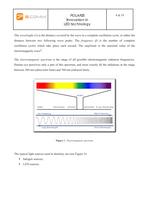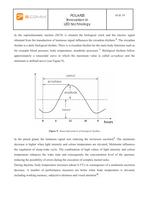 Website:
G.Comm S.r.l.
Website:
G.Comm S.r.l.
Catalog excerpts

POLARIS Innovation in LED technology (technical, perceptive, physiological aspects) Depliant.POL.08.02
Open the catalog to page 1
POLARIS Innovation in LED technology 2 di 19 Preface The aim of a dental lamp is to provide appropriate illumination levels in the treatment zone, assuring the professional and patient’s comfort. The “quality” of light is not only essential for a correct visualization of surgical field (focusing, contrast exaltation, …) and for a faithful perception of colours, but also for the influence that light plays on the physiological processes of the observer. Several studies have demonstrated that the light source characteristics, in terms of colour temperature and luminous intensity, can influence...
Open the catalog to page 3
POLARIS Innovation in LED technology 3 di 19 The light Light is a form of electromagnetic radiation, an electromagnetic field which propagates into space and time, vacuum and matter. The electromagnetic radiation presents the double nature of a particle and a wave: in all processes in which it is generated and absorbed it can be considered made of particles, called photons; propagation into space and time is associated to its wave nature1. It is possible characterized an electromagnetic wave with the following parameters: wavelength; amplitude; frequency. Figure 1. Sketch of a wave and its...
Open the catalog to page 4
POLARIS Innovation in LED technology 4 di 19 The wavelenght (λ) is the distance covered by the wave in a complete oscillation cycle, or rather the distance between two following wave peaks. The frequency (f) is the number of complete oscillation cycles which take place each second. The amplitude is the maximal value of the electromagnetic wave2. The electromagnetic spectrum is the range of all possible electromagnetic radiation frequencies. Human eye perceives only a part of this spectrum, and more exactly all the radiations in the range between 380 nm (ultraviolet limit) and 760 nm...
Open the catalog to page 5
POLARIS Innovation in LED technology 5 di 19 Halogen sources are made of tungsten filaments which overheat emitting light when voltage is applied. LED (Light Emitting Diode) sources exploit the optic properties of some semiconductor materials to emit photons through the electrons-hole couples recombination. A) B) Figure 3. A) Halogen source. B) LED source Visual and non visual effects of light Inside the human eye, the light is focused on a surface sensitive to luminous rays, the retina, through a lens, the crystalline, and a hole, the pupil, the amplitude of which can be modified in order...
Open the catalog to page 6
POLARIS Innovation in LED technology 6 di 19 Figura 4. Eye anatomy The vision is the process through the which light reflected by objects in the environment is translated into mental image. The photoreceptors are responsible of the transduction of light signal in electric signal. Photoreceptors in fact present a membrane containing the visual pigments, called photopigments (see Table 1), sensitive to light. After light absorption, chemical reactions starts and at the end of these reactions the electric signal is produced. Figure 5. Schematic representation of neuronal light pathways
Open the catalog to page 7
POLARIS Innovation in LED technology 7 di 19 There are two types of photoreceptors (see Figure 6): rods; cones. Figure 6. Photoreceptors: cones and rods Rods are involved in nocturnal vision at low illumination level (scotopic vision), while cones are responsible of daytime vision at high illumination level (photopic vision). Cones can be also classified (see Figure 7), in function of the absorption spectrum, in 5: S-cone (short-wavelength sensitive cone); M-cone (middle-wavelength sensitive cone); L-cone (L-cone: long-wavelength sensitive cone). In table 1 is reported for each...
Open the catalog to page 8
POLARIS Innovation in LED technology Photoreceptors Vision Absorbance peak 8 di 19 Colour of maximal sensitivity S-Cone photopic 437 nm blu-violetto M-Cone photopic 533 nm verde L-Cone photopic 564 nm rossi Rods scotopic 507 nm Table 1. Typology of photoreceptors Figure 7. Absorption curve of the three kinds of cones (S-cone, M-cone, L-cone) and rods The electric signal produced by the photoreceptors is processed by horizontal cells, bipolar cells, amacrine cells and ganglion cells (see Figure 8) contained in the retina5. The post processing information is sent through the optic nerve to...
Open the catalog to page 9
POLARIS Innovation in LED technology 9 di 19 Figure 8. Retina anatomy All the phenomenon related to luminous message but not associable to image formation are considered non visual effect of light. Non visual effects of light depend on light intensity and light spectrum. The photoreceptor responsible of non visual effect of light is melaopsin, present in the about 3% of ganglion cells 6. The relative electric signal is sent through the retinahypothalamic tract (RHT) to the suprachiasmatic nucleus (SCN) and consequently through the paraventricular nucleus (PVN) and the superior cervical...
Open the catalog to page 10
POLARIS Innovation in LED technology 10 di 19 In the suprachiasmatic nucleus (SCN) is situated the biological clock and the electric signal obtained from the transduction of luminous signal influences the circadian rhythms 8. The circadian rhythm is a daily biological rhythm. There is a circadian rhythm for the main body functions such as for example blood pressure, body temperature, metabolic processes 3. Biological rhythms follow approximately a sinusoidal curve in which the maximum value is called acrophase and the minimum is defined mesor (see Figure 9). Figure 9. Sinusoidal pattern of...
Open the catalog to page 11
POLARIS Innovation in LED technology 11 di 19 Non visual effect of light can be summarized in: melatonin production decrease; body temperature variation; influence on attention level and mental fatigue. The optimization of light intensity and colour temperature allows to realize a relaxed concentration level and to avoid mental fatigue, reducing the possibility of errors. Colour perception Colour is often defined as an attribute of light perceived by human eye1. However colour is not a physical attribute of an object. When light is absorbed by the photoreceptors of human eye, brain...
Open the catalog to page 12All G.Comm S.r.l. catalogs and technical brochures
-
G.Comm IQNet QMS
1 Pages
-
Nuvola & Nuvolina
2 Pages
-
CoreWhite
2 Pages
-
Monitor Neovo
2 Pages
-
Arms and support systems
2 Pages
-
Lighting
24 Pages
-
VISION Light
4 Pages
-
ISA Light
8 Pages
-
General Catalogue 2012
88 Pages
-
POLARIS dental LED light
10 Pages
-
Electric micromotor ST40
2 Pages
-
Arms and support
2 Pages













